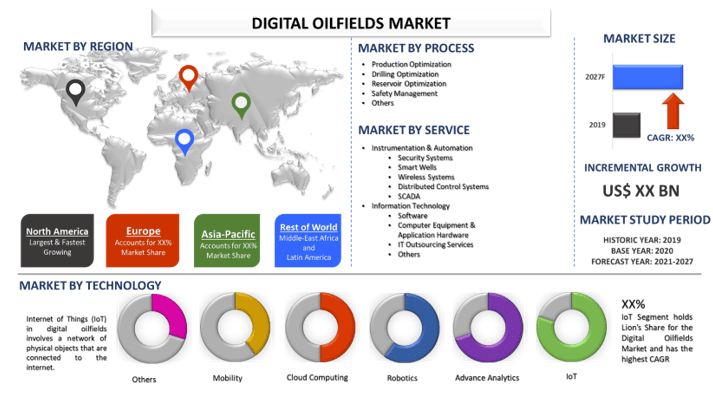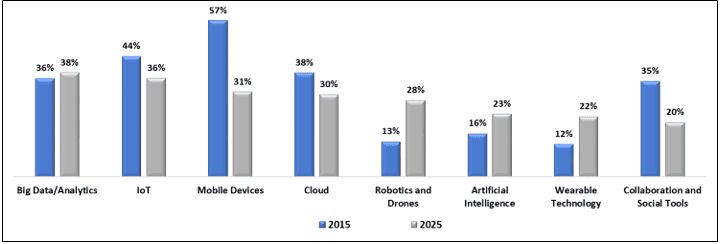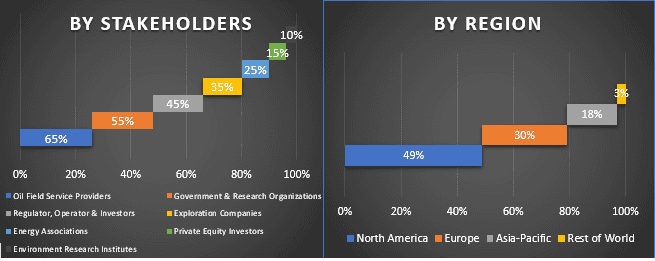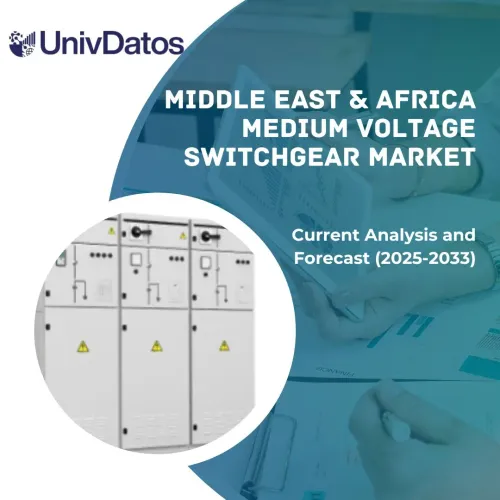- Home
- About Us
- Industry
- Services
- Reading
- Contact Us
Digital Oilfields Market: Current Analysis and Forecast (2021-2027)
Emphasis on Process (Production Optimization, Drilling Optimization, Reservoir Optimization, Safety Management, Others); Application (Onshore, Offshore); Service (Instrumentation & Automation, Information Technology); Technology (IoT, Advance Analytics, Robotics, Cloud Computing, Mobility, Others); and Region/Country
 Digital Oilfield Market was valued at US$ 24 billion in 2020 and is projected to expand significantly with a CAGR of 6% from 2021-2027F to US$ 39 billion in 2027. Digital oilfield is a process which combines the business aspect with digital technologies that leads to automation of workflows and maximization of productivity. In addition to this it also reduces cost and minimizes the overall risk that is associated with oil and gas operations. Digital oilfields are designed such that they can transform the upstream sector by creating a ‘digital twin’ that replicate the performance of an oilfield on the computer. The digital oilfield hopes to improve the attractiveness of the oil and gas sectors by converging operational technology with information technology, especially in a low oil price environment. In the last 15 years, adoption of digital oilfields has gained popularity due to technological advancements like sensing, automation, connectivity and data analytics. A comprehensive implementation of digital oilfields can assist oil and gas companies in increasing operational efficiency, collaboration, production optimization, data integration, workflow automation and decision support. Furthermore, it can benefit in achieving productivity gains through improved reservoir understanding, remote monitoring of drilling and completion operations and through logistics and supply chain optimization.
Digital Oilfield Market was valued at US$ 24 billion in 2020 and is projected to expand significantly with a CAGR of 6% from 2021-2027F to US$ 39 billion in 2027. Digital oilfield is a process which combines the business aspect with digital technologies that leads to automation of workflows and maximization of productivity. In addition to this it also reduces cost and minimizes the overall risk that is associated with oil and gas operations. Digital oilfields are designed such that they can transform the upstream sector by creating a ‘digital twin’ that replicate the performance of an oilfield on the computer. The digital oilfield hopes to improve the attractiveness of the oil and gas sectors by converging operational technology with information technology, especially in a low oil price environment. In the last 15 years, adoption of digital oilfields has gained popularity due to technological advancements like sensing, automation, connectivity and data analytics. A comprehensive implementation of digital oilfields can assist oil and gas companies in increasing operational efficiency, collaboration, production optimization, data integration, workflow automation and decision support. Furthermore, it can benefit in achieving productivity gains through improved reservoir understanding, remote monitoring of drilling and completion operations and through logistics and supply chain optimization.
Digital oilfield is an umbrella term for all technology-centric solutions incorporated advanced data analysis and software systems that are known to enhance the oil recovery process from oilfields. Digital oilfield software’s can replicate the functioning of an oil and gas field by using workflows and predictive analysis that is generated by using information related to wellbores, reservoirs and surface facilities. This helps to simplify the decision making process with the help of intelligently filtered data and optimum utilization of technology. Digitalization of oilfields assists in the effective deployment of both human and machine resources and enhances the overall cost-effectiveness of the operations. Moreover, the discovery of new oilfields is also increasing the need for digital oilfields for example, China discovered a new 1-billion-ton superdeep oil and gas area in the Tarim Basin in the Northwest China’s Xinjiang Uygur Autonomous Region. The rising trend towards digitalization is the key factor for the market growth. In addition to this the increasing demand for oil derivatives across industries and the potentially hazardous working environments in the oilfields are also driving the market growth. Furthermore, oilfields are saturating, owing to digital mechanisms which hare being employed to enhance oil recovery. Additionally, the growing usage of real time monitoring of operations to reduce non-productive functions and losses is also driving the market growth.
Trends in the Digital Technologies Market (%), 2015 & 2025F

Weatherford International, NOV, ABB, Emerson, Rockwell Automation, Siemens, Honeywell International, CGG, Kongsberg and Digi International are some of the prominent players operating in the Digital Oilfields market. Several M&As along with partnerships have been undertaken by these players to facilitate customers with hi-tech and innovative products/technologies.
Insights Presented in the Report
“Amongst Process, Production Optimization segment holds the major share”
Based on Process, the Digital Oilfields market is segmented into Production Optimization, Drilling Optimization, Reservoir Optimization, Safety Management, and Others. Amongst Process, the Production Optimization segment of the market was valued at US$ XX billion in 2020 and is likely to reach US$ XX billion by 2027 growing at a CAGR of XX% from 2021-2027. The major problem with production in that different functions wok in silos which leads to unplanned deferments, reduced operational efficiency and unconnected workers across the production lifecycle. This provokes the need for an integrated and well-packaged solution which encompasses the entire field development lifecycle.
“Amongst Application, Onshore Segment holds the major share”
Based on Application, the Digital Oilfields market is segmented into Onshore and Offshore. Amongst application, Onshore segment accounted for a market valuation of US$ XX billion in 2020 and is expected to reach US$ XX billion by the year 2027, at a CAGR of XX% over the analyzed period. Increase of onshore oilfields in regions like North America and Europe are witnessing a technology-driven revolution which focuses on the efficiency enhancements, reduction in non-productive drilling activity time and improvements in health, safety and environment (HSE) aspects during drilling.
“Amongst Service, Instrumentation & Automation segment holds the major share”
Based on vertical, the Digital Oilfields market is segmented into Instrumentation & Automation and Information Technology. Amongst service, the Instrumentation & Automation segment of the market was valued at US$ XX billion in 2020 and is likely to reach US$ XX billion by 2027 growing at a CAGR of XX% from 2021-2027. Instrumentation and Automation equipment are responsible for communication and surveillance of data for both onshore and offshore fields. According to estimates, process equipment on a typical offshore platform generates one to two terabytes per day. Only around 1% of that data is used in decision making.
“Amongst Technology, IoT segment holds the major share”
Based on Technology, the Digital Oilfields market is segmented into IoT, Advance Analytics, Robotics, Cloud Computing, Mobility and Others. Amongst Technology, the IoT segment of the market was valued at US$ XX billion in 2020 and is likely to reach US$ XX billion by 2027 growing at a CAGR of XX% from 2021-2027. Internet of Things (IoT) in digital oilfields involves a network of physical objects that are connected to the internet. From wearable devices, equipment, vehicles, buildings to just about anything can be embedded with electronics, sensors, software and network connectivity. According to analysts’ digital oilfield technologies will bring a 25% increase to the present value of the deployed assets if data can be efficiently collected and made useful for informing decisions and driving operations.
“North America represents one of the largest markets of Digital Oilfields market”
For a better understanding of the market dynamics of the Digital Oilfields market, a detailed analysis was conducted for different regions across the globe including North America (the U.S, Canada, and the Rest of North America), Europe (Germany, France, Italy, United Kingdom, Spain, and Rest of Europe), Asia-Pacific (China, Japan, India, Australia, and Rest of APAC) and Rest of the World. North America dominated the market and grabbed around XX% market share owing to increasing digitalization and crude oil consumption in the region.
Reasons to buy this report:
- The study includes market sizing and forecasting analysis validated by authenticated key industry experts
- The report presents a quick review of overall industry performance at one glance
- The report covers an in-depth analysis of prominent industry peers with a primary focus on key business financials, product portfolio, expansion strategies, and recent developments
- Detailed examination of drivers, restraints, key trends, and opportunities prevailing in the industry
- The study comprehensively covers the market across different segments
- Deep dive regional level analysis of the industry
Customization Options:
Digital Oilfields market can further be customized as per the requirement or any other market segment. Besides this, UMI understands that you may have your own business needs, hence feel free to connect with us to get a report that completely suits your requirements.
Table of Content
Analyzing the historical market, estimation of the current market, and forecasting the future market of the Digital Oilfields market were the three major steps undertaken to create and analyze the adoption of Digital Oilfields in major regions globally. Exhaustive secondary research was conducted to collect the historical market numbers and estimate the current market size. Secondly, to validate these insights, numerous findings and assumptions were taken into consideration. Moreover, exhaustive primary interviews were also conducted, with industry experts across the value chain of the Digital Oilfields market. Post assumption and validation of market numbers through primary interviews, we employed a top-down/bottom-up approach to forecasting the complete market size. Thereafter, market breakdown and data triangulation methods were adopted to estimate and analyze the market size of segments and sub-segments the industry pertains to. Detailed methodology is explained below:
Analysis of Historical Market Size
Step 1: In-Depth Study of Secondary Sources:
Detail secondary study was conducted to obtain the historical market size of the Digital Oilfields through company internal sources such as annual reports & financial statements, performance presentations, press releases, etc., and external sources including journals, news & articles, government publications, competitor publications, sector reports, third-party database, and other credible publications.
Step 2: Market Segmentation:
After obtaining the historical market size of the Digital Oilfields market, we conducted a detailed secondary analysis to gather historical market insights and share for different segments & sub-segments for major regions. Major segments included in the report as Process, Application, Service, Technology and Region. Further country-level analyses were conducted to evaluate the overall adoption of Digital Oilfields in that region.
Step 3: Factor Analysis:
After acquiring the historical market size of different segments and sub-segments, we conducted a detailed factor analysis to estimate the current market size of Digital Oilfields. Further, we conducted factor analysis using dependent and independent variables such as increasing digitalization of industries and urbanization in developing countries. A thorough analysis was conducted for demand and supply-side scenarios considering top partnerships, merger and acquisition, business expansion, and product launches in the Digital Oilfields sector across the globe.
Current Market Size Estimate & Forecast
Current Market Sizing: Based on actionable insights from the above 3 steps, we arrived at the current market size, key players in the Digital Oilfields market, and market shares of the segments. All the required percentage shares split, and market breakdowns were determined using the above-mentioned secondary approach and were verified through primary interviews.
Estimation & Forecasting: For market estimation and forecast, weights were assigned to different factors including drivers & trends, restraints, and opportunities available for the stakeholders. After analyzing these factors, relevant forecasting techniques i.e., top-down/bottom-up approach was applied to arrive at the market forecast about 2027 for different segments and subsegments across the major markets globally. The research methodology adopted to estimate the market size encompasses:
- The industry’s market size, in terms of value (US$) and the adoption rate of Digital Oilfields across the major markets domestically
- All percentage shares, splits, and breakdowns of market segments and sub-segments
- Key players in the Digital Oilfields market in terms of products offered. Also, the growth strategies adopted by these players to compete in the fast-growing market
Market Size and Share Validation
Primary Research: In-depth interviews were conducted with the Key Opinion Leaders (KOLs) including Top Level Executives (CXO/VPs, Sales Head, Marketing Head, Operational Head, and Regional Head, Country Head, etc.) across major regions. Primary research findings were then summarized, and statistical analysis was performed to prove the stated hypothesis. Inputs from primary research were consolidated with secondary findings, hence turning information into actionable insights.
Split of Primary Participants in Different Regions

Market Engineering
Data triangulation technique was employed to complete the overall market estimation and to arrive at precise statistical numbers of each segment and sub-segment of the Digital Oilfields market. Data was split into several segments & sub-segments post studying various parameters and trends in the areas of type and their type of the Digital Oilfields market.
The main objective of the Digital Oilfields Market Study
The current & future market trends of Digital Oilfields were pinpointed in the study. Investors can gain strategic insights to base their discretion for investments from the qualitative and quantitative analysis performed in the study. Current and future market trends were determined the overall attractiveness of the market at a regional level, providing a platform for the industrial participant to exploit the untapped market to benefit as a first-mover advantage. Other quantitative goals of the studies include:
- Analyze the current and forecast market size of Digital Oilfields in terms of value (US$). Also, analyze the current and forecast market size of different segments and sub-segments
- Segments in the study include areas of type and their subtypes
- Define and analysis of the regulatory framework for the Digital Oilfields industry
- Analyze the value chain involved with the presence of various intermediaries, along with analyzing customer and competitor behaviors of the industry
- Analyze the current and forecast market size of the Digital Oilfields market for the major region
- Major regions studied in the report include North America (the U.S, Canada, and Rest of North America), Europe (Germany, United Kingdom, France, Spain, Italy, and Rest of Europe), Asia-Pacific (China, Japan, India, Australia, and Others), and the Rest of the World
- Company profiles of the Digital Oilfields market and the growth strategies adopted by the market players to sustain in the fast-growing market
Deep dive regional level analysis of the industry
Related Reports
Customers who bought this item also bought










